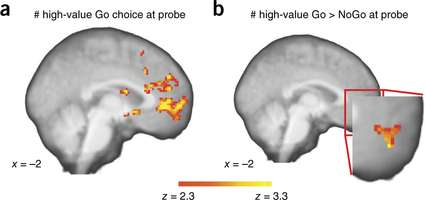March 10, 2014 report
Neuroscientists discover way to increase product value without making changes to it

(Medical Xpress)—A team of researchers working at the University of Texas has discovered a way to cause the perceived value of a product to rise, without changing the product itself: add a button that makes noise. In their paper published in the journal Nature Neuroscience, the team describes experiments they conducted with various volunteers which together suggested that adding a button along with a noise, caused participants to value those associated products more highly.
The idea is simple, though it's difficult to understand why it works. The most basic experiment conducted by the team involved having volunteers look at images of food on a computer screen (after fasting for a minimum of four hours). Prior to looking at the images, each volunteer was asked to state how much they would be willing to pay for general food items. As the volunteers watched, pictures of food were presented, some with a button they were requested to push when they heard an associated noise. Afterwards, each participant was asked to choose between two food items that they had deemed of equal value prior to the computer screen assignment—they chose the item associated with the button and noise 60-65 percent of the time. When queried afterwards, most of the volunteers said they would pay more for that item as well. Thus, the researchers had caused an increase of value perception in the volunteers without altering the food product itself.
The team conducted other experiments as well that involved pre-training volunteers, mixing differently valued items together and mitigating extra time spent looking at an item due to the button pushing and noise making, and found nearly the same results.
The researchers suggest that the change in perceived value of food items in the experiment likely came about as a result of activity in the ventromedial prefrontal cortex—a part of the brain believed to be involved in decision making and comparison. Adding a response mechanism, apparently tips the balance in favor of an already desired product over another. The team also suggests that their findings might help dieticians design vending machines that could help people choose foods that are healthier for them. Of course, it seems that food makers (and the companies that make advertisements for them) could use the same results to cause people to pay more for foods they already like.
More information: Changing value through cued approach: an automatic mechanism of behavior change, Nature Neuroscience (2014) DOI: 10.1038/nn.3673
Abstract
It is believed that choice behavior reveals the underlying value of goods. The subjective values of stimuli can be changed through reward-based learning mechanisms as well as by modifying the description of the decision problem, but it has yet to be shown that preferences can be manipulated by perturbing intrinsic values of individual items. Here we show that the value of food items can be modulated by the concurrent presentation of an irrelevant auditory cue to which subjects must make a simple motor response (i.e., cue-approach training). Follow-up tests showed that the effects of this pairing on choice lasted at least 2 months after prolonged training. Eye-tracking during choice confirmed that cue-approach training increased attention to the cued items. Neuroimaging revealed the neural signature of a value change in the form of amplified preference-related activity in ventromedial prefrontal cortex.
© 2014 Medical Xpress



















